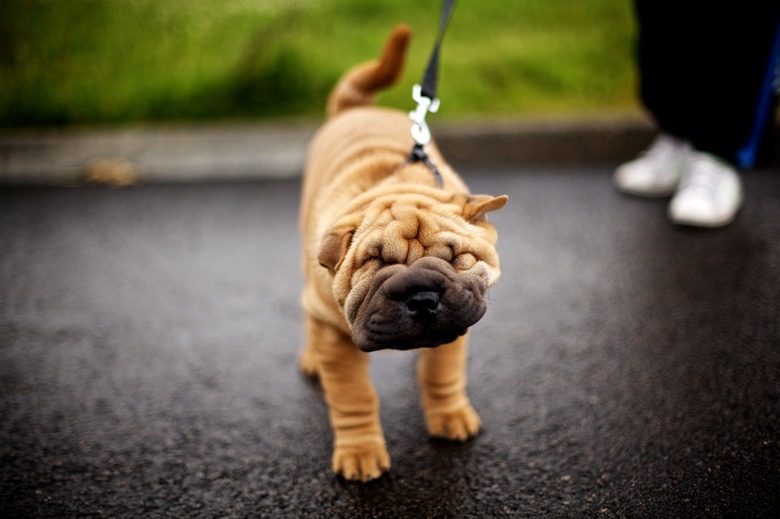Shar Pei (Dog Breed): Temperament, Characteristics & Puppies
Chinese shar-peis, often called simply shar-peis, are strong and powerful dogs that originated in China. Intelligence and loyalty are two common shar-pei dog personality traits. The breed was versatile and may have been used to guard and herd livestock and hunt predators. Today, they still participate in a number of sports, including agility, tracking, and rally. While these dogs can be excellent guardians and are great around families, they are wary of strangers and may not be a good option for a family inexperienced in dog ownership and training.
Shar-pei characteristics
One of the main shar-pei dog characteristics is the copious folds of skin on the head and neck. The folds and wrinkles extend to the dogs' shoulders and body. The breed also features a blue-black tongue, broad muzzle, sunken eyes, and small ears. The tail curls up over the dog's back.
Shar-peis have a short, coarse coat. Translated, their name means "sand skin" or "sand fur." Acceptable colors include red, fawn, black, and blue, and the breed standard allows for markings including a mask, brindle, and white markings. The breed is a member of the American Kennel Club's non-sporting group.
A medium, compact size is another of the shar-pei traits. The dogs grow 18 to 20 inches tall and weigh 45 to 60 pounds.
Shar-pei temperament & training
Breed is not a reliable indicator of personality, however, the Chinese shar-pei personality is described as loyal and independent. They can also be territorial. Use caution when your shar-pei and children interact. While a well-socialized shar-pei can be good with kids in his family, the dog is often wary of strangers and may not react well to unknown children. Always supervise your children and dog when they are interacting.
While these shar-pei dog personality traits allow the breed to excel as guardians, early training and socialization are critical as they can easily become agitated, especially around strangers and some other dogs. The breed can be stubborn during training, so patience and plenty of positive reinforcement are key to success. If you aren't experienced in training dogs or if you run into challenges with your shar-pei, don't hesitate to enroll in an obedience class or hire a professional trainer.
Shar-pei grooming
Shar-peis have a harsh coat and while they frequently shed, they do not require much grooming. Bathe the dog about once per month. Weekly tasks include trimming the nails and cleaning the ears. Use a solution designed for ear cleaning and don't attempt to use cotton swabs or hydrogen peroxide which have the potential to injure a dog's ears.
Shar-pei exercise & health
In general, dogs need regular exercise such as a daily walk. Shar-peis are very adaptable and can acclimate to more or less exercise depending on their family's activity level. Take care when exercising dogs during the warm summer months as they may develop heatstroke.
The breed is susceptible to a number of health conditions. Some genetic conditions that responsible breeders should test for include hip and elbow dysplasia, patella luxation, and autoimmune thyroiditis. The breed is also prone to eye conditions such as glaucoma and retinal dysplasia.
Shar-peis may suffer frequent ear infections as their ears do not allow airflow and they have a narrow ear canal. Their thick, padded lips increase the likelihood of dental disease and infections in the mouth.
Shar-pei puppies
Chinese shar-pei puppies reach their full adult size around 16 months of age. At three months of age, female puppies typically weigh 16.1 to 21.3 pounds while male puppies weigh 21.3 to 25.1 pounds. By the time they are six months old, female puppies grow to 29.6 to 39.6 pounds while the males weigh 39.6 to 46.8 pounds.
